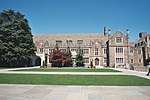Sarah P. Duke Gardens
Botanical gardens in North CarolinaDuke University campusDuke familyProtected areas of Durham County, North Carolina

The Sarah P. Duke Gardens consist of approximately 55 acres (22 ha) of landscaped and wooded areas at Duke University located in Durham, North Carolina. There are 5 miles (8 km) of allées, walks, and pathways throughout the gardens. The gardens are divided into four areas, the Historic Core and Terraces, the H.L Blomquist Garden of Native Plants, the William Louis Culberson Asiatic Arboretum and the Doris Duke Center Gardens (including the Page-Rollins White Garden). The gardens are a memorial to Sarah Pearson Angier Duke, mother of Mary Duke Biddle and wife of Benjamin N. Duke, one of Duke University's benefactors.
Excerpt from the Wikipedia article Sarah P. Duke Gardens (License: CC BY-SA 3.0, Authors, Images).Sarah P. Duke Gardens
Anderson Street, Durham
Geographical coordinates (GPS) Address Nearby Places Show on map
Geographical coordinates (GPS)
| Latitude | Longitude |
|---|---|
| N 36.001802777778 ° | E -78.933483333333 ° |
Address
Roney Fountain
Anderson Street 500
27705 Durham
North Carolina, United States
Open on Google Maps






